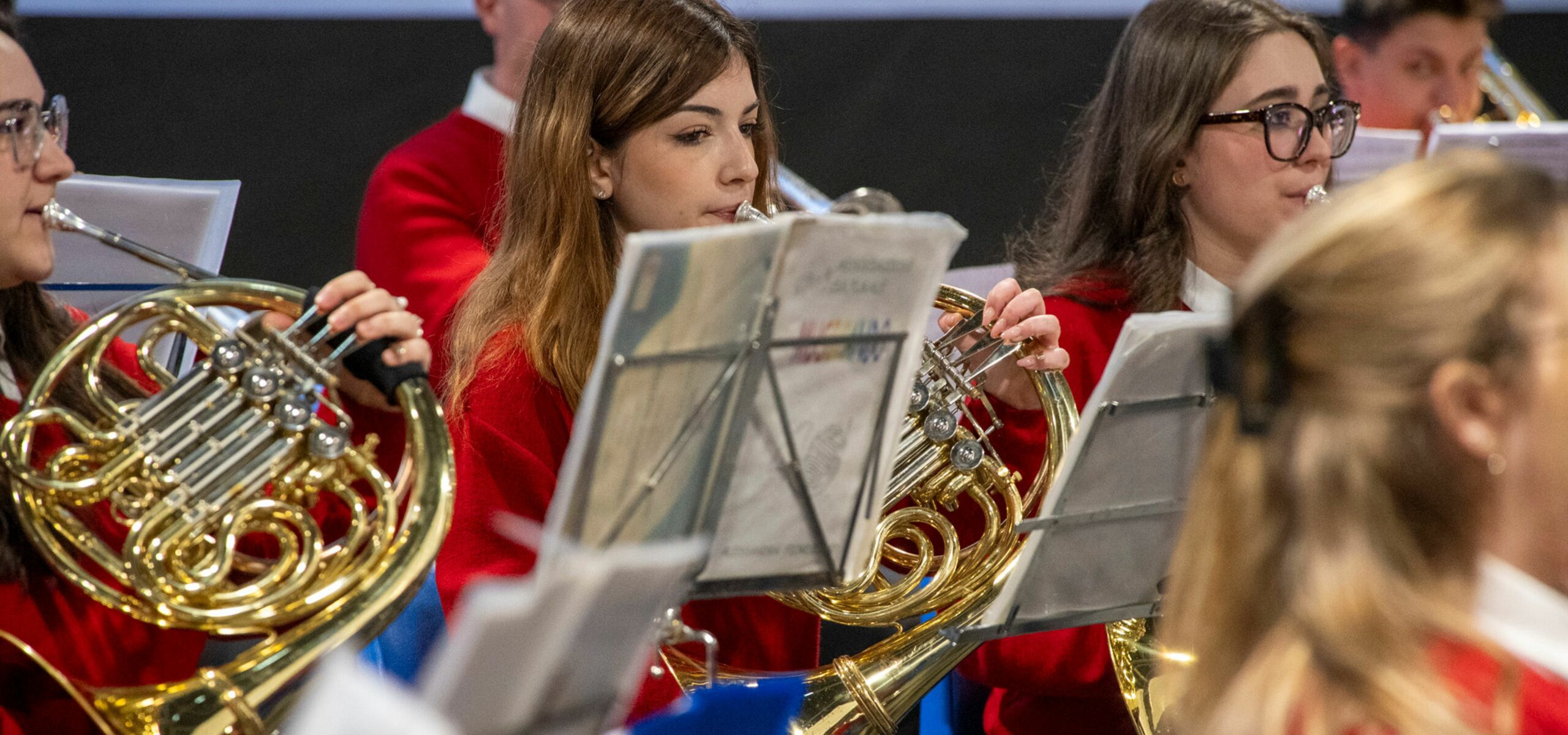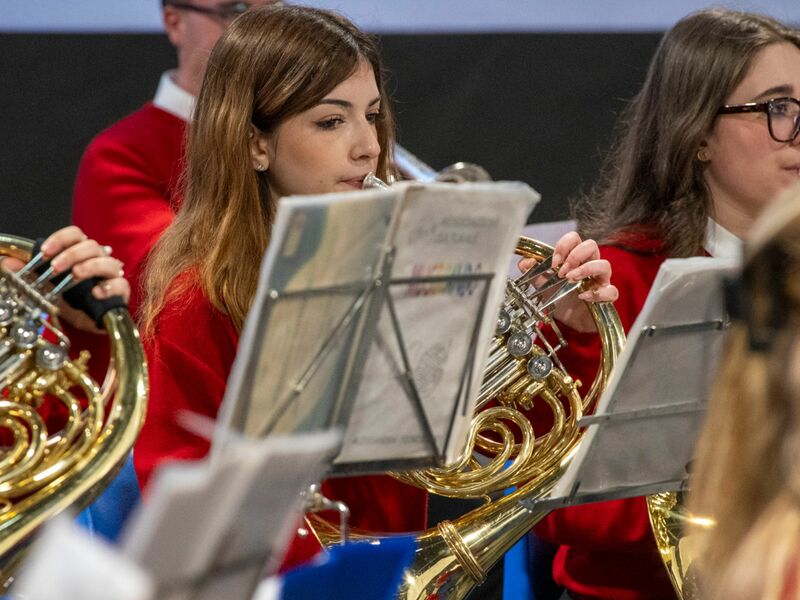Stay updated on the latest news
Discover the spirit of Flicorno d'oro
Compulsory pieces of the Flicorno d'Oro 2025
Let’s present the five compulsory pieces in detail, divided into each category.
EXCELLENCE CATEGORY
Torstein Aagard-Nilsen - SEID
The piece Seid by Torstein Aagaard-Nilsen, composed in 1996 for Brass Band and transcribed for wind ensemble in 2018, is a work that explores themes of transformation and mystery, drawing inspiration from the cultural and mythological traditions of Norway. The title itself, Seid, refers to the Norse shamanic practice, a type of ritual magic used to communicate with spirits and predict the future, deeply connected to the idea of change, alteration of reality, and contact with the divine. In Seid, Aagaard-Nilsen creates a sound texture that evokes uncertainty and fluidity, characteristics of the shamanic world and its ritual practices. The score is marked by an innovative use of instruments, alternating tribal percussion, high-pitched sounds, tremolos, and glissando passages, immersing the listener in an ethereal and ambiguous atmosphere. The resulting sound is both visceral and elusive, as if the band is engaged in a constant process of metamorphosis, where the boundary between the tangible and the intangible, between the real and the unreal, is perpetually blurred. The entire composition unfolds like a sonic narrative, where past and future intertwine, and where each note seems imbued with deep symbolism, evoking images of ancient rituals, journeys into the unknown, and openings to parallel dimensions. It is not music that provides easy answers, but rather music that stimulates introspection and reflection on what is unknown and what can only be revealed through experience and mystery. Aagaard-Nilsen's approach, though deeply rooted in Nordic tradition, also reflects a contemporary musical language in which timbral exploration and formal experimentation form the basis of a fearless sonic search that pushes the boundaries of convention. Seid is therefore a captivating and engaging work, offering a unique sonic experience that immerses the listener in a world of intense emotional and sonic contrasts, where the ancient and the modern merge in a play of shadows and light, presences and absences.
SUPERIOR CATEGORY
Thomas Doss - VAN GOGH
A historical figure both complex and multifaceted, characterized by suffering, genius, and alienation, Vincent Van Gogh is the protagonist of the eponymous composition by Thomas Doss. The musical journey described does not narrate the life of the Dutch painter but seeks to immerse the listener in the palette of colours that defined and accompanied his existence. A world on canvas where colours blend like chords, harmonizing or clashing in dissonance. In every painting, every portrait, every landscape, there is a secret melody that vibrates through the colour—a melody felt more in the heart than in the eyes, a composition that resonates deep within the soul. The opening of Doss's work is titled "Brushes and Colours," a psychotic page that presents, in the background, the awakening of Van Gogh's creative power, fully expressed in the subsequent section, "A Painting is Born." This leads into "Paris-Arles," a diabolical and disorienting waltz, mirroring his Parisian period: new friendships, professional contacts, hopes for success, but also hallucinations and depressive crises caused by alcoholism. From the darkness of his Parisian period arises one of the most famous "nights" in the history of painting: Starry Night. The tormented genius creates calm and magic—a starry sky, still and immutable. This period of great creative fervour soon turns to tragedy "Death and Brotherly Love": Van Gogh wounds himself with a firearm under mysterious circumstances, never revealed even to his beloved brother on his deathbed. The composition concludes with "The Art Market." Amid the general chaos, his paintings sit there, awaiting a sale that would never come during his lifetime. The music grows increasingly tense, and the final abrupt ruptures serve as definitive seals of failure, of not having made it. Not yet.
FIRST CATEGORY
Daniele Carnevali - CINECITTA'
Cinecittà by Daniele Carnevali is a work that, through the fusion of sonic and visual evocations, celebrates the beating heart of Italian culture—the same Italy that has fascinated and captivated the entire world with its inimitable beauty and artistic sophistication. It is not merely a representation of the renowned film studio that hosted immortal masterpieces. Rather, it becomes a sonic archaeology of our tradition, a profound and melodious reflection on national identity, on the essence of "Italianity" that permeates every frame, every note, every heartbeat of the history of the Belpaese. With a musical language rooted in the 20th century, Carnevali draws from a repertoire of citations and references emerging from the collective memory, particularly the extraordinary legacy of Verdi. His pen boldly translates into sound the same grandeur that Giuseppe Verdi gave to operatic music, yet with the freshness and modernity of a vision inspired by the aesthetics of the seventh art, sometimes with the imaginative breath that characterizes the poetics of Nino Rota. Carnevali’s sonorities resonate as a bridge linking the operatic tradition to contemporary times, in a timeless dialogue. The listener, immersed in these atmospheres, feels enveloped by the decontextualized elegance of Verdi’s grand themes, which are here reinterpreted through the lens of a 20th-century musical language. The quotations, which feel like tributes, emerge within the orchestral textures like flashes of a memory that never fades, like the long shadows of a history renewed through art. This composition is not just a tribute but a true reinvention of memory, a vibrant and contemporary affirmation of what it means to be Italian—of how Italy itself has written its story in the languages of cinema and music, and of how, today more than ever, it continues to live, to flow, to be the protagonist of a narrative that knows no end.
SECOND CATEGORY
Oliver Waespi - CALEDONIA
The wild and mysterious lands of Scotland, with their spectacular landscapes, ancient legends, and a rich musical tradition full of evocative themes, deeply inspired Oliver Waespi in composing Caledonia. The title itself, the ancient Latin name for Scotland, evokes a sense of inaccessibility and a profound connection with nature. The piece explores a rich tonal palette, alternating moments of great emotional intensity with passages of contemplative calm. Waespi skilfully uses the wind orchestra to create soundscapes that seem to reflect the contrast between the majestic beauty and ruggedness of the Scottish landscape. The composition, characterized by a musical language rooted in the tradition of reworking folk themes, offers extraordinary moments of lyricism and serenity contrasted with bursts of energy and drama, reflecting the diverse and unpredictable nature and history of Scotland.
THIRD CATEGORY
Massimo Sgargi - FAIR PLAY
Fair Play by Massimo Sgargi is a musical fantasy inspired by a popular melody from Bologna: La fira ed San Lazer. While maintaining its connection to its folk inspiration, the piece stands out for its ability to rework and refresh the musical material, transforming it into a sonic reflection rich in surprises and inventiveness. Sgargi plays with the original melody, treating it with great freedom and turning it into a fascinating rhythmic and harmonic exploration, where polymeters and polyrhythms enhance the liveliness of the composition in Allegro, contrasted with the intense and intimate atmospheres of the Adagio section. The result is a dynamic composition in which the approach to elaborating folk music highlights the technical and expressive possibilities of a wind orchestra. It is a decidedly challenging piece for a third category, but one that will bring great satisfaction and gratification to the performers.

